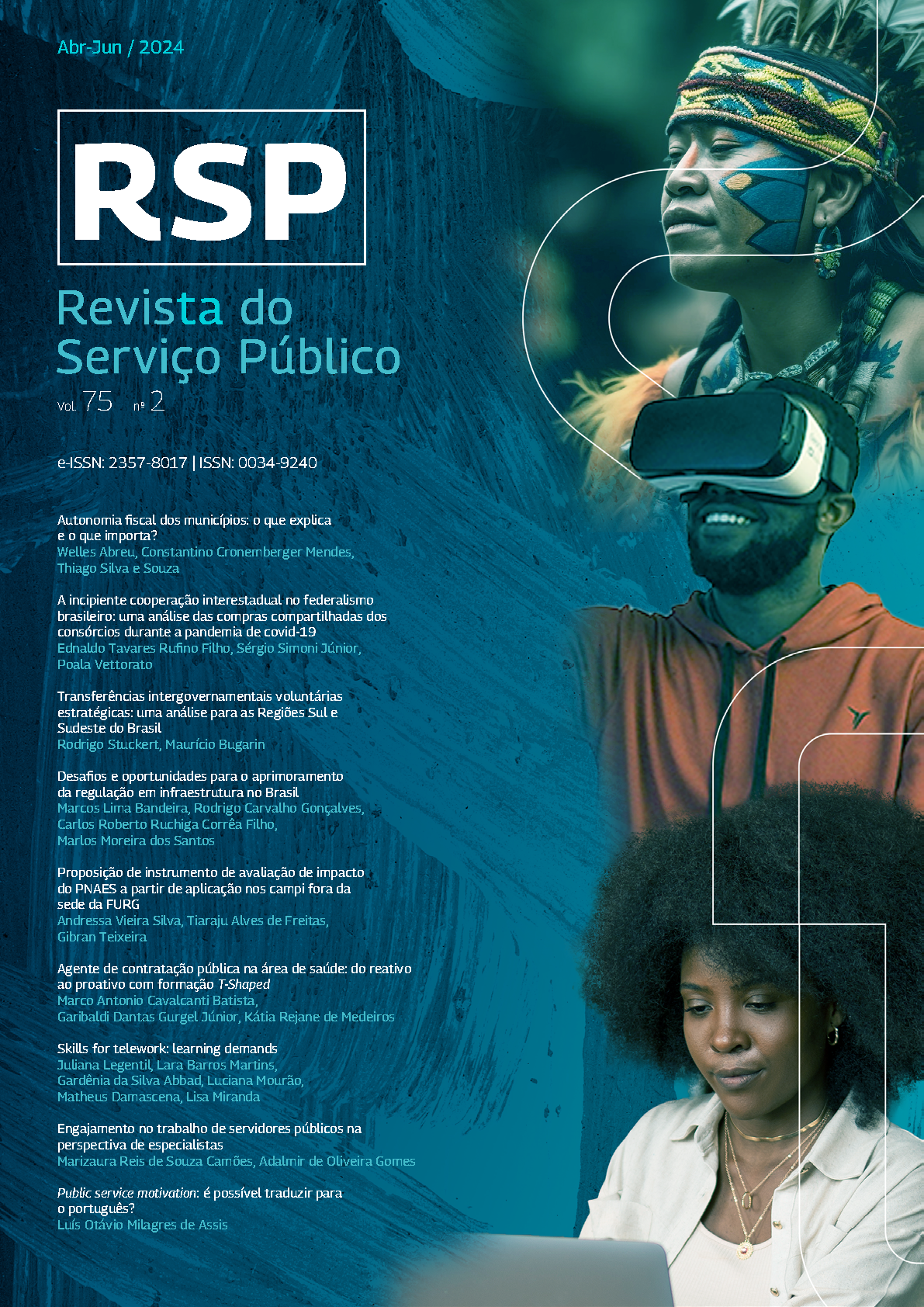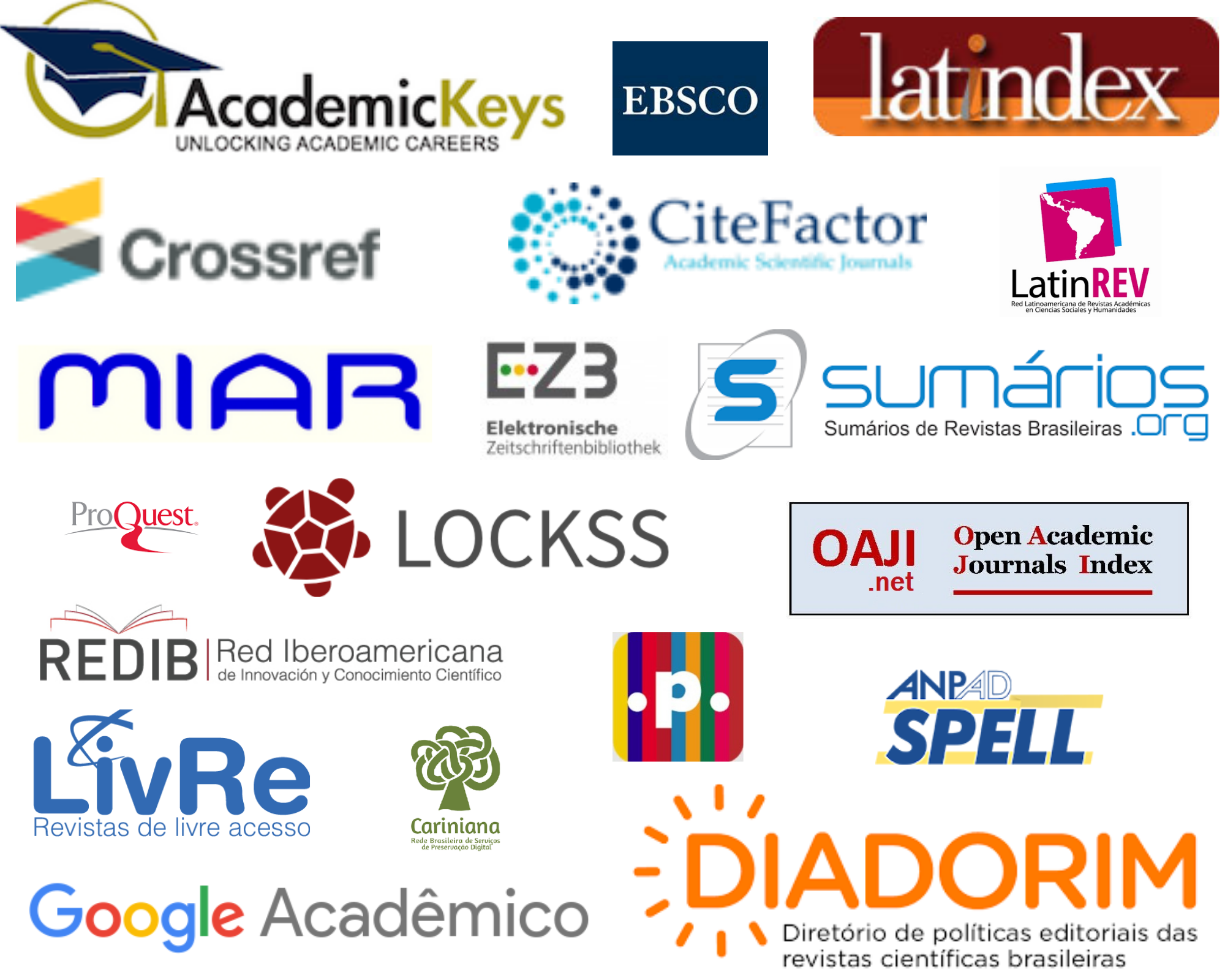Skills for telework
learning demands
DOI:
https://doi.org/10.21874/rsp.v75i2.10255Keywords:
learning needs, hard skills, soft skills, public sector, mandatory teleworkAbstract
Mandatory telework introduced requirements for performing activities remotely. Some were different from those required for voluntary telework. Being full-time at home brought substantial changes to the workers’ lives who were not adapted to this modality of work. This study aimed to identify the skills deemed necessary for teleworking. It was based on the perspective of 2,409 professionals working in 95 Brazilian public institutions. The results were divided into two central categories: hard skills and soft skills. Some of the features pointed out by the participants that needed to be improved were: being able to master the technological tools used to communicate remotely; productivity management; and time management. When gaps in expressing such skills are identified, relevant educational actions can be promoted. In addition, it is possible to leverage the benefits and reduce the risks associated with telework.
Downloads
References
ABBAD, G. S.; LEGENTIL, J. (2020). Novas demandas de aprendizagem dos trabalhadores face à pandemia da COVID-19. In: MORAES, M. M. (org.). Os impactos da pandemia para o trabalhador e suas relações com o trabalho. Porto Alegre: Artmed. v. 2, p. 49–58. https://www.sbpot.org.br/publicacao/volume-2-os-impactos-da-pandemia-para-o-trabalhador-e-suas-relacoes-com-o-trabalho/.
ABBAD, G. S.; MOURÃO, L. (2012). Avaliação de necessidades de TD&E: Proposição de um novo modelo. RAM. Revista de Administração Mackenzie, v. 13, n. 6, p. 107–137. https://www.redalyc.org/articulo.oa?id=195424913006.
ADERALDO, I. L.; ADERALDO, C. V. L.; LIMA, A. C. (2017). Critical aspects of telework in a multinational company. Ebape. BR, v. 15, p. 511–533. https://doi.org/10.1590/1679-395160287.
ALLEN, T. D.; MERLO, K.; LAWRENCE, R. C.; SLUTSKY, J.; GRAY, C. E. (2021). Boundary management and work‐nonwork balance while working from home. Applied Psychology, v. 70, n. 1, p. 60-84. https://doi.org/10.1111/apps.12300.
ANDERSON, D.; KELLIHER, C. (2020). Enforced remote working and the work-life interface during lockdown. Gender in Management: An International Journal, v. 35, n. 7/8, p. 677–683. https://doi.org/10.1108/GM-07-2020-0224.
BARDIN, L. (2016). Análise de Conteúdo. São Paulo: Edição 70.
BARTSCH, S.; WEBER, E.; BÜTTGEN, M.; HUBER, A. (2021). Leadership matters in crisis-induced digital transformation: How to lead service employees effectively during the COVID-19 pandemic. Journal of Service Management, v. 32, n. 1, p. 71–85. https://doi.org/10.1108/JOSM-05-2020-0160.
BEAUREGARD, T. A.; BASILE, K. A.; CANONICUS, E. (2019). Telework: Outcomes and facilitators for employees. In: LANDERS, R. N. (ed.). The Cambridge handbook of technology and employee behavior. Cambridge, UK: Cambridge University Press. p. 511–543.
BEHAM, B.; BAIERL, A.; POELMANS, S. (2015). Managerial telework allowance decisions – a vignette study among German managers. International Journal of Human Resource Management, v. 26, n. 11, p. 1385–1406. https://doi.org/10.1080/09585192.2014.934894.
BERGUE, S. T. (2020). Gestão Estratégica de Pessoas no Setor Público. 2 ed. Belo Horizonte: Fórum.
BLOOM, N.; HAN, R.; LIANG, J. (2022). How hybrid working from home works out. Technical report, National Bureau of Economic Research, p. 1-21.
BOULET, M.; PARENT-LAMARCHE, A. (2022). Paradoxical Effects of Teleworking on Workers’ Well-Being in the COVID-19 Context: A Comparison Between Different Public Administrations and the Private Sector. Public Personnel Management, v. 51, n. 4, p. 430–457. https://doi.org/10.1177/00910260221102943.
BREGENZER, A.; JIMENEZ, P. (2021). Risk factors and leadership in a digitalized working world and their effects on employees' stress and resources: Web-Based questionnaire study. Journal of Medical Internet Research, v. 23, n. 3, p. e24906. https://doi.org/10.2196/24906.
CHARALAMPOUS, M.; GRANT, C. A.; TRAMONTANO, C.; MICHAILIDIS, E. (2019). Systematically reviewing remote e-workers' well-being at work: a multidimensional approach. European Journal of Work and Organizational Psychology, v. 28, n. 1, p. 51–73. https://doi.org/10.1080/1359432X.2018.1541886.
CHOI, S. (2018). Managing Flexible Work Arrangements in Government: Testing the Effects of Institutional and Managerial Support. Public Personnel Management, v. 47, n. 1, p. 26–50. https://doi.org/10.1177/0091026017738540.
CHUNG, H., & BOOKER, C. (2023). Flexible Working and the Division of Housework and Childcare: Examining Divisions across Arrangement and Occupational Lines. Work, Employment and Society, 37(1), 236-256. https://doi.org/10.1177/09500170221096586
CHUNG, S.; ZHAN, Y.; NOE, R. A.; JIANG, K. (2021). Is it time to update and expand training motivation theory? A meta-analytic review of training motivation research in the 21st century. Journal of Applied Psychology, v. 107, n. 7, p. 1150–1179. https://doi.org/10.1037/apl0000901.
CONSELHO NACIONAL DE JUSTIÇA. (2022). Resolução CNJ n. 481, de 22 de novembro de 2022. Revoga as Resoluções vigentes à época da pandemia do Coronavírus e altera as Resoluções CNJ n. 227/2016, 343/2020,345/2020, 354/2020 e 465/2022. In Atos CNJ Jus. https://atos.cnj.jus.br/files/original125734202211286384b03e81656.pdf
COSTA, F. L. (2010). Contribuição a um projeto de reforma democrática do estado. Revista de Administração Pública, v. 44, p. 239-270.
CRESWELL, J. W.; CRESWELL, J. D. (2021). Projeto de pesquisa: Métodos qualitativo, quantitativo e misto. 5. ed. Porto Alegre: Penso Editora.
DOLCE, V.; VAYRE, E.; MOLINO, M.; GHISLIERI, C. (2020). Far away, so close? The role of destructive leadership in the job demands–resources and recovery model in emergency telework. Social Sciences, v. 9, n. 11, p. 1–22. https://doi.org/10.3390/socsci9110196.
FLEISS, J. L.; COHEN, J. (1973). The equivalence of weighted kappa and the intraclass correlation coefficient as measures of reliability. Educational and Psychological Measurement, v. 33, n. 3, p. 613–619. http://dx.doi.org/10.1177/001316447303300309.
FRAIJ, J. (2021). E-HRM to overcome HRM: Challenges in the pandemic. SEA - Practical Application of Science, v. IX, n. 25, p. 41–49. https://seaopenresearch.eu/Journals/articles/SPAS_25_5.pdf.
GAJENDRAN, R. S.; HARRISON, D. A. (2007). The good, the bad, and the unknown about telecommuting: Meta-Analysis of psychological mediators and individual consequences. Journal of Applied Psychology, v. 92, n. 6, p. 1524–1541. https://doi.org/10.1037/0021-9010.92.6.1524.
GIAUQUE, D.; RENARD, K.; CORNU, F.; EMERY, Y. (2022). Engagement, Exhaustion, and Perceived Performance of Public Employees Before and During the COVID-19 Crisis. Public Personnel Management, v. 51, n. 3, p. 263–290. https://doi.org/10.1177/00910260211073154
GOLDEN, T. D.; GAJENDRAN, R. S. (2018). Unpacking the role of a telecommuter’s job in their performance: Examining job complexity, problem solving, interdependence, and social support. Journal of Business and Psychology, v. 34, n. 1, p. 55–69. http://dx.doi.org/10.1007/s10869-018-9530-4.
GONZÁLEZ-ANTA, B.; ORENGO, V.; ZORNOZA, A.; PEÑARROJA, V.; GAMERO, N. (2021). Sustainable virtual teams: Promoting well-being through affect management training and openness to experience configurations. Sustainability, v. 13, n. 6, p. 3491. https://doi.org/10.3390/su13063491.
GREEN, D. D.; ROBERTS, G. E. (2010). Personnel implications of public sector virtual organizations. Public Personnel Management, v. 39, n. 1, p. 47–57. https://doi.org/10.1177/009102601003900103.
KNIFFIN, K. M.; NARAYANAN, J.; ANSEEL, F.; ANTONAKIS, J.; ASHFORD, S. P.; BAKKER, A. B.; BAMBERGER, P.; BAPUJI, H.; BHAVE, D. P.; CHOI, V. K.; CREARY, S. J.; DEMEROUTI, E.; FLYNN, F. J.; GELFAND, M. J.; GREER, L. L.; JOHNS, G.; KESEBIR, S.; KLEIN, P. G.; LEE, S. Y.; OZCELIK, H.; PETRIGLIERI, J. L.; ROTHBARD, N. P.; RUDOLPH, C. W.; SHAW, J. D.; SIROLA, N.; WANBERG, C. R.; WHILLANS, A.; WILMOT, M. P.; VUGT, M. V. (2021). COVID-19 and the workplace: Implications, issues, and insights for future research and action. American Psychologist, 76(1), 63–77. https://doi.org/10.1037/amp0000716.
LAKER, D. R.; POWELL, J. L. (2011). The differences between hard and soft skills and their relative impact on training transfer. Human Resource Development Quarterly, v. 22, n. 1, p. 111–122. https://doi.org/10.1002/hrdq.20063.
LANDIS, J. R.; KOCH, G. G. (1977). The measurement of observer agreement for categorical data. International Biometric Society, v. 33, n. 1, p. 159–174. https://doi.org/10.2307/2529310.
LANKA, E.; LANKA, S.; ROSTRON, A.; SINGH, P. (2021). Why we need qualitative research in management studies. Revista de Administração Contemporânea, v. 25, n. 2, p. e200297. https://doi.org/10.1590/1982-7849rac2021200297.en.
LU, Zhuofei; ZHUANG, Wei. (2023). Can teleworking improve workers’ job satisfaction? Exploring the roles of gender and emotional well-being. Applied Research in Quality of Life, v. 18, n. 3, p. 1433-1452. https://doi.org/10.1007/s11482-023-10145-4
MADLOCK, P. (2012). The influence of supervisors’ leadership style on telecommuters. Journal of Business Strategies, v. 29, n. 1, p. 1–24. https://search.ebscohost.com/login.aspx?direct=true&db=bsx&AN=77472590&lang=pt-br&site=eds-live&scope=site.
MARTINS, L. B.; AGUIAR, C. V. N.; BASTOS, A. V. B. (2020). COVID-19: Seus impactos na relação trabalho-família. In: QUEIROGA, F. (ed.). Orientações para o home office durante a pandemia da COVID-19. Porto Alegre: Artmed. v. 1, p. 49–58. https://www.sbpot.org.br/publicacao/volume-1-home-office-guidelines-in-the-covid-19-pandemic-2/.
MEDEIROS, M.; PINHEIRO, L. S. (2018). Desigualdades de gênero em tempo de trabalho pago e não pago no Brasil. Revista Sociedade e Estado, v. 33, n. 1, p. 159–185. http://dx.doi.org/10.1590/s0102-699220183301007.
MELE, V., BELARDINELLI, P., & BELLÉ, N. (2023). Telework in public organizations: a systematic review and research agenda. Public Administration Review, 83(6), 1649-1666. https://doi.org/10.1111/puar.13734
MENDONÇA, Inês et al. (2022). Telework and mental health during COVID-19. International Journal of Environmental Research and Public Health, v. 19, n. 5, p. 2602. https://doi.org/10.3390/ijerph19052602
MENDONÇA, M.; MATOS, P. M. (2015) Conciliação família-trabalho vivida a dois: Um estudo qualitativo com casais com filhos pequenos. Análise Psicológica, v. 3, n. 33, p. 317–334. http://dx.doi.org/10.14417/ap.904.
MESSENGER, J.; LLAVE, O. V.; GSCHWIND, L.; BOEHMER, S.; VERMEYLEN, G.; AND WILKENS, M. (2017) Working anytime, anywhere: The effects on the world of work. Publications Office of the European Union and the Geneva: International Labour Office. https://www.eurofound.europa.eu/sites/default/files/ef_publication/field_ef_document/ef1658en.pdf.
MINISTÉRIO DA GESTÃO E DA INOVAÇÃO EM SERVIÇOS PÚBLICOS. (2023). Instrução Normativa Conjunta SEGES-SGPRT /MGI no 24, de 28 de julho de 2023. Estabelece orientações a serem observadas pelos órgãos e entidades integrantes do Sistema de Pessoal Civil da Administração Federal - Sipec e do Sistema de Organização e Inovação Institucional do Governo Federal - Siorg, relativas à implementação e execução do Programa de Gestão e Desempenho - PGD. In Diário Oficial da União, Edição 144, Seção 1, Página 57. https://www.in.gov.br/en/web/dou/-/instrucao-normativa-conjunta-seges-sgprt-/mgi-n-24-de-28-de-julho-de-2023-499593248
MOROSANOVA, V. I.; BONDARENKO, I. N.; KONDRATYUK, N. G. (2021). Regulatory resources and emotional states in overcoming difficulties of self-organization during lockdown. Psychological Studies, v. 66, p. 280–290. https://doi.org/10.1007/s12646-021-00611-0.
NEIROTTI, P.; PAOLUCCI, E.; RAGUSEO, E. (2012). Telework configurations and labour productivity: Some stylized facts. International Journal of Engineering Business Management, v. 4, p. 1–10. https://doi.org/10.5772/51641.
PEÑA-JIMENEZ, M.; BATTISTELLI, A.; ODOARDI, C.; ANTINO, M. (2021). Explorando habilidades requeridas para la industria 4.0: Un enfoque orientado al trabajador. Anales de Psicología, v. 37, n. 3, p. 577–588. https://doi.org/10.6018/analesps.444311.
PÉREZ-NEBRA, A. R.; QUEIROGA, F.; MARTINS, L. B.; MODESTO, J. G.; BERTOLINO, M. (2022). Decent work housebound: Recovery experiences of parents during the pandemic. GÉNEROS – Multidisciplinary Journal of Gender Studies, v. 11, n. 2, p. 144-171. https://doi.org/10.17583/generos.7583.
RAJAN, P. (2000). Teleworking: Training and educational needs. Economic and Political Weekly, v. 35, n. 26, p. 2299–2304. https://www.epw.in/journal/2000/26/special-articles/teleworking-training-and-educational-needs.html.
SANDALL, H.; MOURÃO, L. (2020). Job Performance: Challenges for Workers and Managers. In: QUEIROGA, F. (ed.). Home office guidelines in the COVID-19 pandemic. Brasília: SBPOT Publications. v. 1, p. 19-25. (Collection: Work and containment measures for COVID-19: contributions from Work and Organizational Psychology in the pandemic context). https://www.sbpot.org.br/publicacao/volume-1-home-office-guidelines-in-the-covid-19-pandemic/.
SNELROVE, C. (2021). How has COVID-19 affected telework attitudes and behaviors? Carolina Digital Repository, p. 1–26. https://doi.org/10.17615/pyd9-nj65.
STOKER, J. I.; GARRETSEN, H.; LAMMERS, J. (2021). Leading and working from home in times of COVID-19: On the perceived changes in leadership behaviors. Journal of Leadership and Organizational Studies, v. 29, n. 2, p. 208–218. https://doi.org/10.1177/15480518211007452.
TOLENTINO, M. J. M.; OLIVEIRA, K. P. de; CASTRO, M. A. A. de. (2023). Teletrabalho na pandemia: percepções de trabalhadores do Poder Executivo de Minas Gerais. Revista do Serviço Público, v. 74, n.2, p. 462-486. https://doi.org/10.21874/rsp.v74i2.7848
TROLL, E. S.; VENZ, L.; WEITZENEGGER, F.; LOSCHELDER, D. D. (2022). Working from home during the COVID-19 crisis: How self-control strategies elucidate employees' job performance. Applied Psychology, v. 71, p. 853-880. https://doi.org/10.1111/apps.12352
van ZOONEN, W., ter HOEVEN, C. L. (2022). Disruptions and General Distress for Essential and Nonessential Employees During the COVID-19 Pandemic. Journal of Business and Psychology, v. 37, p. 443-458. https://doi.org/10.1007/s10869-021-09744-5
VAZIRI, H.; CASPER, W. J.; WAYNE, J. H.; MATTHEWS, R. A. (2020). Changes to the work-family interface during the COVID-19 pandemic: Examining predictors and implications using latent transition analysis. Journal of Applied Psychology, v. 105, n. 10, p. 1073–1087. http://dx.doi.org/10.1037/apl0000819.
VILARINHO, K. P. B.; PASCHOAL, T.; DEMO, G. (2021). Teletrabalho na atualidade: quais são os impactos no desempenho profissional, bem-estar e contexto de trabalho? Revista do Serviço Público, v. 72, n.1, p. 133-162. https://doi.org/10.21874/rsp.v72i01.4938
VITAK, J.; CROUSE, J.; LAROSE, R. (2011). Personal Internet use at work: Understanding cyberslacking. Computers in Human Behavior, v. 27, n. 5, p. 1751–1759. https://doi.org/10.1016/j.chb.2011.03.002.
WANG, B.; LIU, Y.; QIAN, J.; PARKER, S. K. (2021). Achieving effective remote working during the COVID‐19 pandemic: A work design perspective. Applied Psychology, v. 70, n. 1, p. 16–59. https://doi.org/10.1111/apps.12290.
Downloads
Published
How to Cite
Issue
Section
License
Copyright (c) 2024 Revista do Serviço Público

This work is licensed under a Creative Commons Attribution-NonCommercial-ShareAlike 4.0 International License.
- A RSP adota a licença Creative Commons (CC) do tipo Atribuição – Uso Não-Comercial (BY-NC).
- A licença permite que outros remixem, adaptem e criem obra licenciada, sendo proibido o uso com fins comerciais.
- As novas obras devem fazer referência ao autor nos créditos e não podem ser usadas com fins comerciais, porém não precisam ser licenciadas sob os mesmos termos dessa licença.
- Ao publicar o artigo na RSP, o autor cede e transfere para a ENAP os direitos autorais patrimoniais referentes ao artigo.
- O artigo publicado na RSP não poderá ser divulgado em outro meio sem a devida referência à publicação de origem.
- O autor que tiver o artigo publicado na RSP deverá assinar o Termo de Concessão de Direitos Autorais (em momento oportuno a editoria da Revista entrará em contato com o autor para assinatura do Termo).



